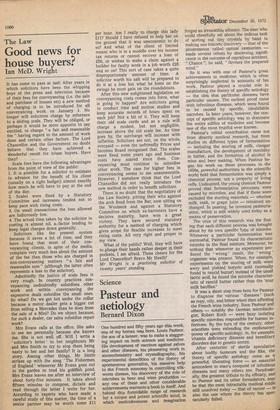Science
Pasteur and aetiology
Bernard Dixon
One hundred and fifty years ago this week, one of my heroes was horn. Louis Pasteur, the son of a tanner, was to make a staggering impact on both science and medicine. His development Of vaccines against rabies and other diseases, his pioneering work in stereochemistry and crystallography, his experimental demolition of the theory of spontaneous generation, his massive help to the French economy in controlling silkworm disease, his discovery of the role of microbes in beer and wine production — any one of these and other considerable 'achievements warrants a book in itself. And behind this formidable range of research lay a unique and potent scientific mind, in which meticulousness and imagination forged an irresistible alliance. The man Who could cheerfully set about the tedious task of 'sorting out tiny 'crystals by hand in making one historic discovery — that of the phenomenon 'called optical isomerism. made made several others by discerning significance in the outcome of capricious accident. "Chance ", he said, "favours the prepared mind."
So 'it was with one of Pasteur's great achievements in medicine, 'which is often surprisingly neglected in 'accounts of his work, Pasteur played a crucial role in establishing the theory of specific aetiology — the idea that particular diseases have particular causes. The earliest 'proof came with infectious diseases, which 'were found to 'be ,caused by specific, identifiable microbes. In later years, however, the concept of 'specific aetiology 'vvas to dominate the entire 'edifice 'of medicine and become one of the most fruitful ever known.
Pasteur's initial contribution came not from directly medical research, but from Studies on different types of fermentation — including the souring of milk, vinegar manufadture, the development of rancidity in butter, and the formation of alcohol in Wine 'and beer making. When Pasteur began his work on these processes in the 1850s, powerful authorities in the scientific world held that fermentation was simply a 'chemical process, not a 'property of living cells. Undaunted, the young 'chemist Pasteur proved that fermentation 'processes were caused by microbes, and that if these were excluded the 'starting materials whether milk, malt, or grape juice — remained unchanged. In passing, he invented 'pasteurisation, which is still 'widely used today as a means of preservation.
The 'crux of this research was the finding that each different process was brought about by its 'own specific type of microbe. Whenever a particular fermentation was successful, Pasteur found its characteristic microbe in the final mixture. Moreover, he noticed that whenever an experiment 'produced the wrong r result, the ' wrong ' organism was present. When, for example, experiments on the souring of milk went awry and yielded butyric acid (normally found in rancid butter) instead of the usual lactic acid, he found the microbe characteristic of rancid butter rather than the 'sour milk bacillus?
It was a short step from, here for Pasteur to diagnose the various 'diseases' (such as ropy, oily, and bitter Wine) then affecting the French .Wine industry. Soon Pasteur and others — notably the German microbiologist, Robert Koch — were busy isolating specific microbes responsible for human infection's. By the turn of the century, other scientists 'were extending the 'explanatory power of 'specific aetiology, in, for example, vitamin deficiency diseases and hereditary disorders due to genetic errors.
After centuries of sterile speculation about bodily 'humours 'and the like, the theory of 'specific aetiology came as a 'powerful, liberating force L-7' an essential antecedent to man's 'conquest of infectious diseases and many others too. Paradoxically, the 'greatest tribute to its efficacy, and to Pasteur and its other formulators, may that the most intractable medical riddle still unsolved today — that of cancer — is 'also the one 'where the theory has spec tacularly 'failed. '


































 Previous page
Previous page